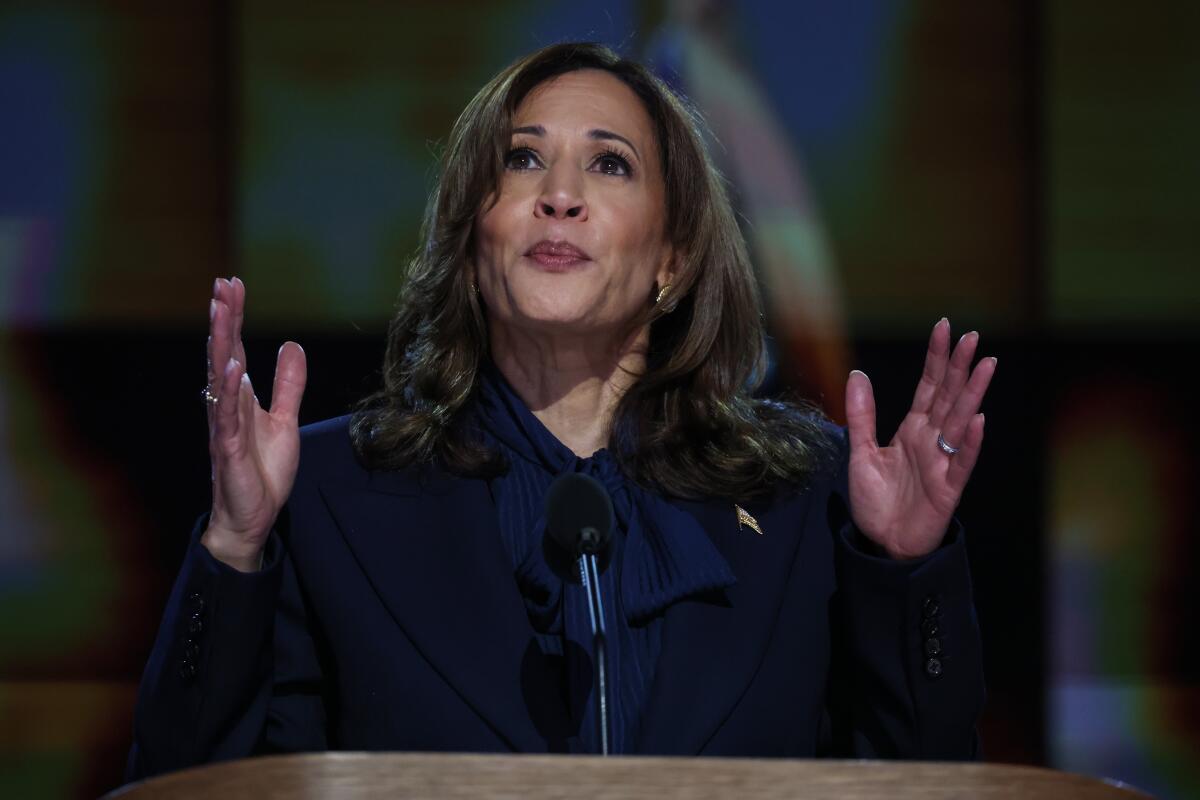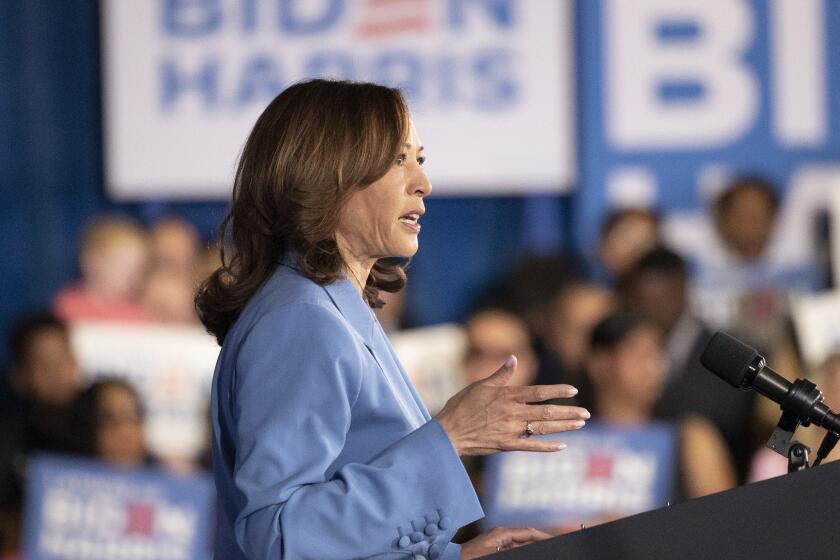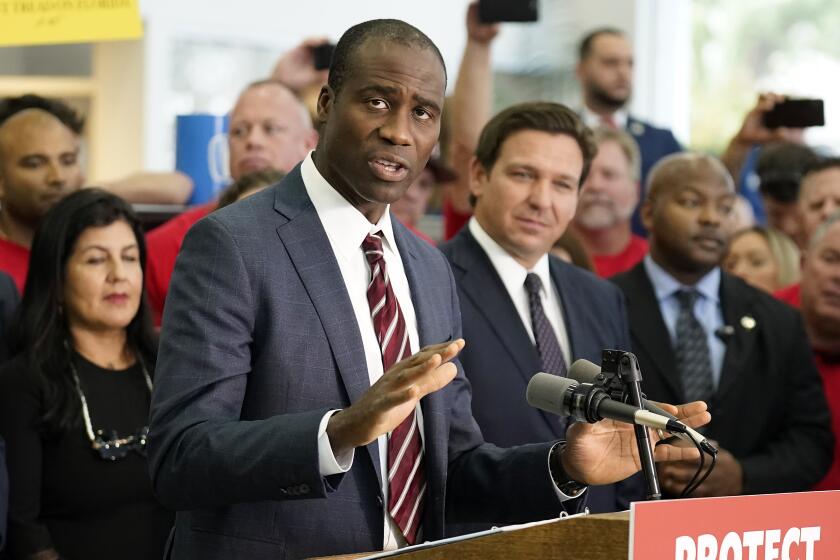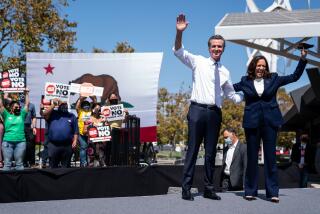The rise of Kamala Harris shows that our political ‘polarization’ was always a myth

- Share via
A funny thing happened after July 21, when President Biden ended his campaign for reelection. It’s not merely that Kamala Harris emerged to take his place; it’s that her campaign had overcome the polarization of American politics.
At least, that’s the reading provided by not a few political pundits. But it’s not quite true. The reality is that Harris’ rise as a leading political figure demonstrates that America was never as polarized as our commentators claimed.
I made this point nearly three years ago, in the wake of the failed recall effort against Gov. Gavin Newsom. The recall failed by a 2-to-1 vote. As I observed at the time, the commentariat persisted in viewing the result through the prism of the “polarization” theme, even though it demonstrated conclusively that in California, at least, there was broad agreement, not disagreement, about Newsom’s policies on fighting COVID, abortion and gun control.
Another four years of Donald Trump’s chaotic leadership, this time focused on advancing the dangerous goals of Project 2025, will hurt real, everyday people and weaken our sacred institutions.
— Letter from 200 former Republican aides endorsing Kamala Harris for president
Harris has (so far) finessed the polarization meme by making an explicit appeal to voters based on issues likely to find widespread conformity across the partisan spectrum. These include abortion rights (despite the issue’s appearance as a wedge driving Americans apart) and economic policies aimed at the middle class.
The harvest appears to be a surge in cross-party support for the Harris campaign. On Monday, more than 200 former Republican aides to presidents George W. and George H.W. Bush and Sens. Mitt Romney and John McCain endorsed Harris in an open letter, stating that “another four years of Donald Trump’s chaotic leadership, this time focused on advancing the dangerous goals of Project 2025, will hurt real, everyday people and weaken our sacred institutions.”
Get the latest from Michael Hiltzik
Commentary on economics and more from a Pulitzer Prize winner.
You may occasionally receive promotional content from the Los Angeles Times.
A dozen lawyers who served Ronald Reagan and both Bushes in the White House issued their own joint endorsement, stating, “We believe that returning former President Trump to office would threaten American democracy and undermine the rule of law in our country.”
The Harris campaign, emboldened by positive polls, is seeking to expand its presence into Sun Belt states that were either judged out of reach or leaning Republican, such as Georgia, Arizona and North Carolina.
Yet it may be more accurate to view these developments not as Harris overcoming polarization, but as her exposing the shallowness of the polarization impression. Political scientists have increasingly come to the conclusion that the apparent polarization of debate in the U.S. is an artifact of where that debate has been conducted — chiefly on social media.
“At first blush, the American political landscape can seem quite bleak, in part because of heightened political polarization,” observed researchers from UC Berkeley and Columbia University in March. But they found that “the landscape of debate is distorted by social media and the salience of negativity present in high-profile spats.”
The misimpression among Americans, they wrote, fosters “a false reality about the landscape of debate which can unnecessarily undermine their hope about the future.”
Hiltzik: Trump says Harris stole his idea for exempting tips from tax, but her version beats his
The presidential candidates are squabbling over tax exemption for tips, but Harris’ version helps workers and Trump’s helps the rich
The methods used by social media platforms to grab and hold users’ attention deserves much of the blame for this distortion, they asserted. “There is evidence that negative information spreads more quickly on social media and is often amplified by social media algorithms that promote or push content to the forefront of users’ pages,” they wrote.
“This negativity is exacerbated by non-human actors or ‘bots’ that often inflame online conflicts .... These factors combined suggest that negative, conflict-laden debates will flow to the top of people’s timelines.”
A similar conclusion was reached by political scientists James Druckman of the University of Rochester, Matthew Levendusky of the University of Pennsylvania and their colleagues, who found in a 2020 paper that the “hyper-partisan polarization” that defined current American politics in the 21st century was “affective polarization” — meaning that when people were asked in surveys about the party whose policies they opposed, was based on “stereotypes and media exemplars of ideologically extreme and politically engaged partisans.”
What was happening, they wrote, was that people incorrectly assumed that those extremists “comprise the majority of the other party.”
Another factor is Trump, who “is also a polarizer: he takes existing trends and pours gasoline on them,” Levendusky told me.
Still, the image of a hopelessly polarized America is belied by opinion polls and ballot results on individual issues. Nearly two-thirds of Americans feel that abortion should be legal in all or most cases, according to a survey issued in May by the Pew Research Center. That’s higher than it was in 1995.
More evidence comes from abortion-related ballot initiatives in seven states in 2022 and 2023, following the Supreme Court’s overturning of Roe vs. Wade: The pro-abortion rights position prevailed in every one, including in the red states Ohio, Kansas and Kentucky. Abortion rights measures will be on the ballot in 10 states this November, including Florida, Missouri, Nebraska and South Dakota.
Rasmussen’s polls used to be known for their pro-GOP bias. It has now moved on to pushing anti-vaccine nonsense
Sizable majorities also are seen in opinion polls in favor of stricter gun laws and antipandemic measures such as masking and social distancing. COVID vaccines may be the target of obstreperous antivaccination fanatics, but most Americans have voted with their feet by walking into vaccine clinics: 81% of Americans have received at least one shot and 70% are considered fully vaccinated with multiple doses.
That includes states in which antivaccination politics reign, such as Florida, where the Republican-appointed surgeon general, Joseph Ladapo, has issued antivax recommendations so misleading that he was publicly rebuked by the Centers for Disease Control and Prevention and the Food and Drug Administration. Despite Ladapo’s antivax propaganda, 81.4% of Floridians have received at least one shot and 68.6% are considered fully vaccinated.
As for the homogenizing of the major parties’ opposing positions on matters of public concern — liberals becoming Democrats and conservatives becoming Republicans — that’s not polarization so much as what Levendusky described as “the partisan sort” in his 2009 book of the same name. Voters take their cues from the leaders of their favored party, he noted, “looking to elites who share their values to figure out where they stand on the issues.”
“People have gotten a bit more divided over time, but much less than people think,” Levendusky says. “People have sorted themselves so that Democrats are now mostly one side of the issue, and Republicans on the other. A generation ago, you had lots of pro-environment Republicans, pro-choice Republicans (and pro-life Democrats!), Democrats who were strong gun rights supporters, and so on. Now, that’s much less true.”
Republicans criticizing Biden’s student debt relief plan took millions of dollars in pandemic relief loans and never paid them back. But they say that’s different.
What is true is that the platforms of the two major parties have moved further apart; more precisely, while the Democratic Party stayed where it had been, slightly left of center, the Republican Party moved distinctly toward the extreme right.
The reason, Levendusky argued in his book, was the flow of evangelicals and other fundamentalist Christians into the Republican Party starting in the 1970s. Party leaders — the “elite,” in Levendusky’s term — moved rightward to accommodate this new, outspoken bloc; some nonfundamentalist party members followed along, but most remained centrist on economic issues and abortion rights.
This process is relatively new in American politics. During the New Deal, the most obdurate critics of Franklin Roosevelt’s policies were Democrats — Southern Democrats, to be sure, but his party members nonetheless — while among his most loyal supporters were liberal Republicans. One of the two aides who served in FDR’s Cabinet for all 12 of his years in office, Harold Ickes, was a Republican. (The other was Frances Perkins, a Democrat.) Lyndon Johnson had to trample over opposition by the Southerners in his party to get the Civil Rights and Voting Rights acts passed in the 1960s.
Just as the Republicans had a progressive wing, the Democrats had a conservative wing comprising Wall Street bankers and corporate executives such as Alfred P. Sloan, the chairman and chief executive of General Motors. Sloan and his fellow rich reactionaries established a rump anti-New Deal bloc, the American Liberty League, to lobby against FDR’s policies from inside the Democratic Party.
FDR rhetorically drummed them out of the party — their “two particular tenets,” he said, are that “you should love God and then forget your neighbor” — but they remained part of the party until the league disbanded in 1940.
In recent years, Levendusky observed, there has been a shift in both parties toward the extremes. But it’s not as pronounced as social media posters and political commentators would have it. “The majority of the electorate remain closer to the center than to the poles.”
That’s where Harris is right now, which may be the key to her placing the “polarization” ogre in its grave for good.
More to Read
Get the latest from Michael Hiltzik
Commentary on economics and more from a Pulitzer Prize winner.
You may occasionally receive promotional content from the Los Angeles Times.













